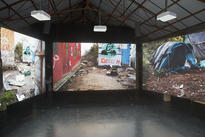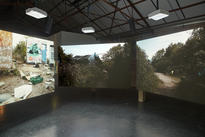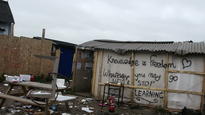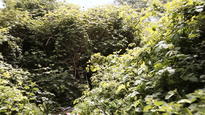LIMBO
In the middle of the journey of our life,
I came to myself, in a dark wood,
where the direct way was lost.
(Canto Primo, Inferno, Dante)
The starting point of the project is the 5 channels video installation Limbo that physically aims to stage, through a vortex movement so dear to the Italian poet Dante Alighieri, the perpetual drive of migration. Made while he was working on Kalès, Van Lancker brings us again into the Calais' Jungle. In the six sequences filmed in the abandoned refugee camp, he evokes the feeling of disorientation and the eternal stream of migrants. This limbo – from Latin limbus that means edge or boundary and it mostly refers to the "edge" of Hell – is not a speculative idea about the afterlife condition, but a real place of encounters and negotiations, a specific situation for thousands of people in a motion to improve their lives. Van Lancker's Limbo is neither the Dante's fictional first circle of the abyss in the Inferno where Dante comes upon all virtuous non-Christians including Homer, Julius Caesar, Saladin, Aristotle, Democritus, Euclid or Averroes. Yet the people who have been living in Calais are not damned, nor renowned. Van Lancker keeps them faceless and lets only distant voices merging with windy murmurs and footsteps. Starting from a bucolic woods, the camera moves into clusters of abandoned tents, improvised neighbourhoods of precarious shacks, almost utopian social spaces such as a library. Then it scans interiors and their surroundings where waste and leftovers tell about migrants' daily activities. Instead of dwelling on the miserabilism, Van Lancker wants to open our eyes and have us look from a different angle at a complex whole that is probably all too often felt to be a social burden and that may lead us to draw the wrong conclusions. Nevertheless, Limbo presents a dialogue between poetry and politics. In this respect, the quotes from the Divine Comedy take new actual meanings when juxtaposed to the images of the aban- doned camp. In fact, the instant disman- tle left the camp in a sort of Pompeian atmosphere, a frozen status that reveals the daily dynamics within the people living in the camp. Taking down the camps has certainly not solved the matter of the migratory flows, but it has disrupted a microcosm of social life, gatherings, sharing, strategies of adaptability and hopes.





- Format DIGITAL FILE(DIGITAL FILE)
- Color system PAL
- Color col.
- Year 2018
- Duration 00:10:04
- Languageinfo
Running text/titles: English UK
-
Artists
-
EVENTS